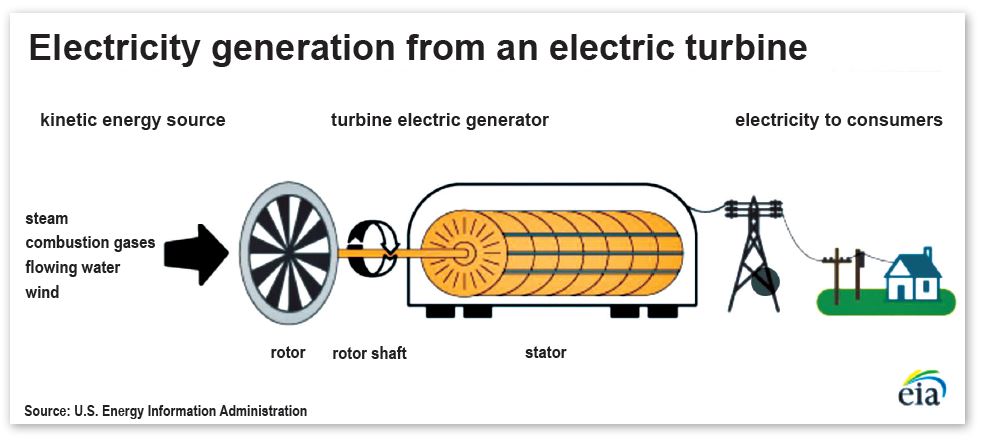Written on: April 8, 2024 by George Carey
With the current emphasis on electrification coming at us from all directions, including local, State and Federal agencies, there is a lot of talk about electrifying everything. That has me thinking a lot about electricity—what, actually, is it? How is electricity produced?
Like water and air, most people tend to take electricity for granted. However, when you stop and think about it, we use electricity to do many jobs every day—from lighting, heating and cooling homes to maintaining daily hygiene to powering televisions, computers and cell phones. Imagine what life would be like without it.
Electricity is a form of energy: the flow of electrons. If we take a walk down memory lane to high school science class, we learned that all matter is made up of atoms, and the center of an atom is called a nucleus. The nucleus contains positively charged particles called protons and uncharged particles called neutrons. Surrounding the nucleus are negatively charged particles called electrons. The negative charge of the electron is equal to the positive charge of the proton, and number of each is usually the same. When this balance between protons and neutrons is upset by an outside force, the atom may gain or lose an electron. When electrons are “lost”, the free movement of these electrons makes up an electric current.
Lightning, for example, is a form of electricity; it occurs when electrons move from one cloud to another or jump from a cloud to the ground. Have you ever experienced a shock when you touch an object after walking across the carpet? That “static electricity” is caused when a stream of electrons transfers from that object
to you.
Electricity is part of nature and one of the most widely used forms of energy. Considered a secondary energy source, electricity comes from the conversion of other sources of energy, such as natural gas, nuclear power, coal, oil and other natural sources called primary sources. This is why, many years ago, towns and cities were built along waterfalls (a primary source of mechanical energy) that used waterwheels to convert the falling water into useful power.
How is electricity generated?
An electric generator converts mechanical energy into electrical energy. It is based upon the relationship between magnetism and electricity. When a wire (which can conduct electricity) moves across a magnetic field, an electric current occurs on the wire. The electric utilities have large generators with a stationary conductor. A magnet is attached to the end of a rotating shaft, located inside the conductor, which is wrapped with a long, continuous piece of wire. As the magnet rotates, it induces an electric current in each section of the wire. All these small currents add up to one current of considerable size—which is used for electric power.
The electric utility power stations either use turbines, engines, water wheels or similar machines to drive an electric generator that can convert the mechanical energy to electricity. Steam turbines, water turbines, gas combustion turbines and wind turbines are the common methods used to generate electricity.
Most of the electricity in the U.S. is produced using steam turbines. The turbine converts kinetic energy of fluid moving (liquid or gas) to mechanical energy.

Different types of turbines
1. Fossil-fueled steam turbines: Fuel (such as coal, oil and natural gas) burns in a boiler or furnace, heating water to produce steam. The steam, in turn, pushes on the blades of the turbine.
2. Natural gas: When burned, natural gas produces hot combustion gases that pass directly through a turbine, spinning the blades to generate electricity.
3. Nuclear power: In a nuclear plant, a reactor contains nuclear fuel (typically enriched uranium). When the atoms of uranium are hit by neutrons, they fission (split), releasing heat and more neutrons; those neutrons then strike other uranium atoms, releasing even more heat. This continuous process of nuclear fission releases a tremendous amount of heat, which then turns water into a steam that spins a turbine, generating electricity.
4. Hydropower: In this process, flowing water (either from reservoirs created by dams or free-flowing rivers) is used to apply pressure to the turbine blades to spin the generator, producing electricity.
5. Solar power: Derived from the energy of the sun, this process is called photovoltaic conversion. Electricity is generated directly from the light of the sun in a photovoltaic (solar) cell. Solar-thermal electric generators use the radiant energy from the sun to produce steam to drive turbines
6. Wind power: Energy contained in the wind is converted into electricity. As the wind blows, it turns the blades of the wind turbine, generating electricity.
These last four turbines—sometimes categorized as “renewable energy sources”—do not rely on fossil fuels to spin the turbine blades of the electric generator.
The electricity produced by the generator travels along cables to a transformer, which changes the electricity from low voltage to high voltage. The reason for this is that electricity can be moved long distances more efficiently using the high voltage. The transmission lines are used to carry the electricity to a substation, where transformers change the high-voltage electricity back into lower-voltage electricity. From the substation, distribution lines carry electricity to homes, offices and factories which require the low-voltage electricity.
Electricity is measured in units of power called watts, in honor of James Watt who invented the steam engine. One watt would be considered a very small amount of power. A kilowatt represents 1,000 watts. A kilowatt-hour (kWh) is equal to the energy of 1,000 watts working for one hour. The amount of electricity a power plant generates, or a customer uses over a period of time, is measured in kilowatt-hours (kWh).
In Part 2, we will discuss how electricity works, the terminology associated with electrical circuits and the wiring strategies used to deliver this “invisible energy” throughout a structure.
If you have any questions or comments, e-mail me at gcarey@fiainc.com, call me at (800) 423-7187 or follow me on X at @Ask_Gcarey. ICM